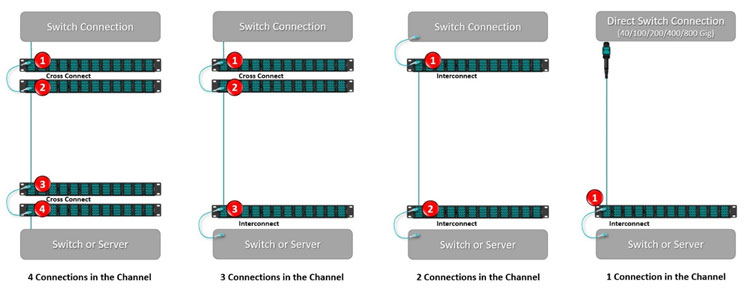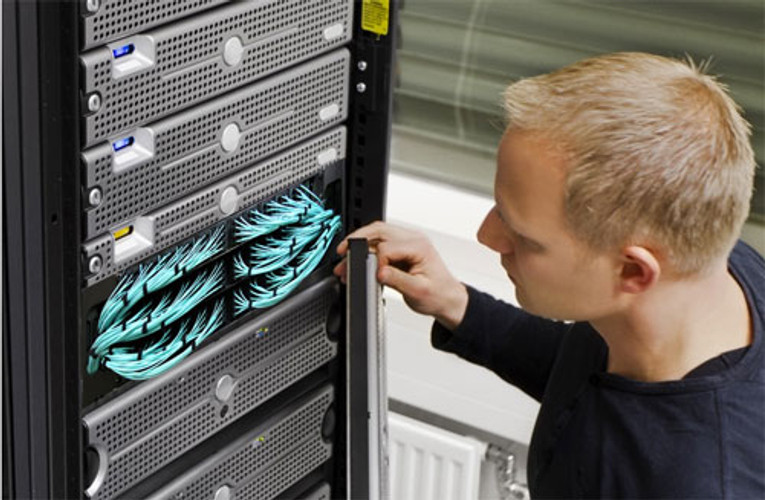
If you’re new to the industry or just happen to work in an area of IT that doesn’t deal with the cabling infrastructure, you might be wondering exactly what a fiber patch panel is and how it’s used. In reality, a fiber patch panel is not exactly a sexy network component—it’s not an expensive piece of active equipment with intelligence and data routing capabilities like a switch or something that can enable communication between network devices. In fact, a fiber patch panel doesn’t actually DO anything.
A completely passive device that is simple in its design and function, fiber patch panels compliment active equipment by housing fiber optic connectivity to create convenient connection points for distributing fiber within a network. But while that might not sound overly exciting, the value of the fiber patch panel cannot be overlooked.
Why Fiber Optic Patch Cables are a Network Management Must
Networks today encompass more fiber optic links than ever before. In service provider networks, they provide the means for connecting businesses, homes, communities, cities, and regions to each other and to the global Internet. In the data center, they enable switch-to-switch and switch-to-server communications that get critical data where it needs to be. In the LAN, fiber links connect the spaces and equipment that enable daily digital business communications and transactions, stream audio and video to phones and digital displays, and pretty much handle anything we do that requires connectivity. An enterprise business (think typical office environment) may only contain anywhere from 10 to 1000 fiber links, while large data centers (think Facebook and Google) contain tens of thousands, and a service provider network (think Verizon and AT&T) can be comprised of millions. Regardless of network type or size, the fiber patch panel is critical.
Networks undergo constant change with new equipment and devices continually being added and links reconfigured to support ever-evolving business needs, bandwidth demand, and a growing number of users. The best way to facilitate those changes is through fiber patch panels, either in an interconnect or cross connect scenario. In an interconnect, fiber patch panels connect directly to active equipment (e.g., switch or server) using short fiber patch cords (i.e., jumpers) to distribute connectivity from one piece of equipment to another. The fiber between the two panels is permanent. In a cross connect, the connectors on one fiber panel are replicated to another fiber panel so that the switch-to-panel connections are also permanent.
So what does all this have to do with network management? Fiber links can be easily reconfigured by simply moving the patch cords – either between the equipment and the patch panel in an interconnect or between the two panels in a cross connect. There are multiple options for using interconnects and/or cross connects as shown below. The benefit of using cross connects over the interconnects is that there is no need to access critical switch ports when making changes. In fact, in most data center environments, cross connects often reside in separate cabinets to keep switches completely separate and secure. One consideration in a fiber network however is that each connection point in a channel adds insertion loss. Designers therefore need to be cognizant of their loss budgets and select innovative lower-loss patch panel solutions when deploying cross connects as discussed in our blog on the Top 5 Tips for Reducing Fiber Insertion Loss.

Patch panels also help organize the fiber links. With hundreds of fiber links coming in and out of equipment, it can be quite easy to lose track of which port connects to which equipment and things can become tangled and messy over time with changes. It’s much easier to manage changes with only short patch cords at the patch panel. Patch panels also have built in cable management to help route the cables and maintain proper bend radius that is critical to maintaining data transmission performance.
How Fiber Patch Panels Provide Value to a Data Center
We often hear that fiber patch panels are critical for scalability, fast network expansion, flexibility, and even revenue—especially in wholesale or colocation data centers. But how exactly do they do this? The beauty of the patch panel is that fiber panels located in different spaces (either within a data center or a building) can be linked with permanent cabling. When new equipment needs to come on line, all that is required is a short patch cord to quickly make the connection between the active equipment and the patch panel. This eliminates the costly and time consuming process of pulling new end-to-end cable for more cost-effective “go as you grow” scalability and rapid expansion.
The use of fiber patch panels also offers greater flexibility in virtualized data center environments where storage and computation resources are often distributed across multiple servers. For example, through the use of main cross connects located in the core or storage area network, any equipment port can be connected to any server regardless of its location.
The revenue-generating aspect of a fiber patch panel is obvious in a wholesale or colocation data center. In these environments, separate cross connects connect service provider equipment in meet-me rooms and tenant areas in the white space. When new tenants come into a space, or an existing tenant needs to expand their services, connections can be made at the cross connect to connect tenants quickly, easily, and securely to services. And in these environments where service level agreements (SLAs) rule, the faster those connections are made, the greater the revenue. Colocations with ample cross connects can also attract more service providers and therefore attract more tenants.
Types of Fiber Patch Panels and Considerations
Fiber patch panels are available with a variety of singlemode and multimode fiber connectivity. Choose from Wall Mount or Rack Mount models, depending on the application. They can be wall mounted or rack mounted and come in a variety of sizes, densities, and configurations. They can house fiber adapters that mate two terminated ends of the same fiber cabling or cassettes that transition from one type of connectivity to another. Our high-density HD8² ultra-high density system comes with duplex or multi-fiber MTP adapters for creating connections in duplex or multi-fiber links, or it comes with cassettes that allow for transitioning from MTP to duplex connectivity.
The use of cassettes offers the advantage of saving pathway space and speeding deployment of the permanent link between patch panels. For example, our 16-strand HD8² cassettes feature 8 duplex connections on the front with only two MTP ports at the back for just two quick connections of the permanent links and about 75% pathway space savings. Cassettes are also ideal for breakout applications that allow for connecting a single high-speed MTP application to multiple lower-speed duplex applications, such as in a 4X25, 4X50, or 4X100 Gig scenarios as we explained in the previous blog, “Duplex and MPO Connectivity—Better Together.”
When selecting a fiber patch panel, some key considerations include:
- Density – Fiber patch panel density is critical to ensuring that you have the capacity to support current and future needs in as little space as possible.
- Flexibility – Fixed fiber patch panels with one type of connectivity can limit flexibility and waste space versus modular panels that allows you to mix and match different connectivity to support a variety of applications in the same panel.
- Cable Management and Labeling – When choosing a fiber panel, make sure to look for wire management to help route and protect cables and label identification capabilities to support proper administration.
- Fast and Easy Installation – Fiber patch panels should be quick and easy to install without a lot of complicated parts and components. They should be easy to mount in both rack- and wall-mount applications and allow for fast, easy snap in of adapters and cassettes.
- Performance – The actual performance of the fiber connectivity that goes into the patch panel is a consideration, especially in high-speed applications that have more stringent insertion loss requirements and may limit how many connections can reside within a channel. There are innovative low-loss solutions like our HDReadyLink™ integrated cassette trunks that significantly reduce insertion loss.
At CablesPlus USA, we offer a variety of easy-to-deploy fiber patch panels—from ultra-high-density data center patch panels to wall-mount service provider distribution panels—all with a wide range of modular connectivity for ultimate flexibility and superior performance and cable management. Click HERE to view our breadth of fiber products or contact us at sales@cablesplususa.com or 866-678-5852 to discuss your specific project need.

